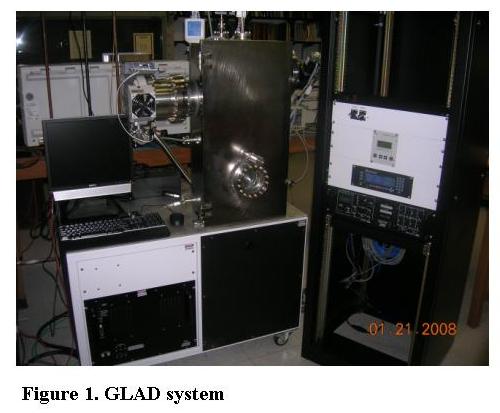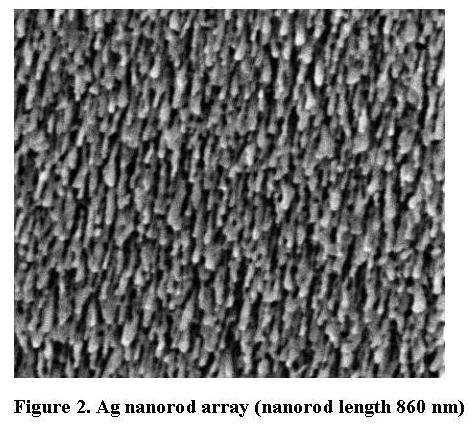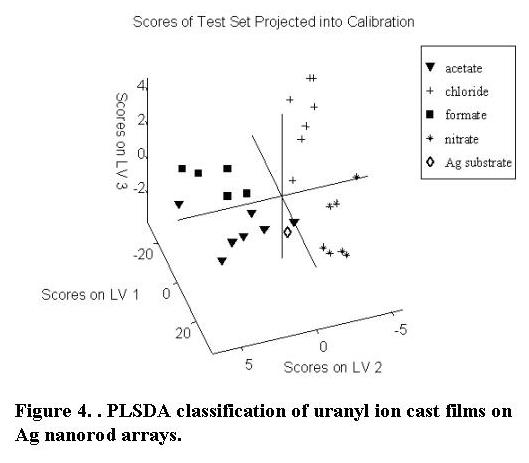

45862-GB5
Influence of Nanostructure Design on the Structure and Spectroscopic Characterization of Self-Assembled Organic Films Deposited onto Novel Metallic Surfaces
The primary goals of this project are 1) to fundamentally understand nanofilm organization and structure of various chemical systems onto non-planar surfaces 2) to understand the influence of nanostructure design on the surface-enhanced infrared absorption enhancement phenomena, and 3) to introduce undergraduates to nanotechnology and involve them in the research process.
Since the start of this PRF award period in January of 2007, the accomplishments to date include 1) the development of a glancing angle vapor deposition (GLAD) system that is designed to fabricate the novel nanostructures, 2) the production of silver nanorod arrays that represent the non-planar substrates that will be used to investigate nanofilm organization and the SEIRA effect, 3) the initial observation of spectral bands of two separate assembled organic nanofilms onto the nanorod arrays, 4) the observation of SEIRA enhancement from nanorod arrays, and 5) the creation of a website to promote these research activities to the local community and to the spectroscopy community as a whole. The nanorod arrays produced from this study have also been used for the trace detection and differentiation of cast films of various uranium systems. These additional undergraduate research opportunities have been funded by the U. S. Department of Energy.
Since the beginning of this award period, the grant funds provided for this project have led to a recent manuscript submission to the international journal, Vibrational Spectroscopy. Every four years, this journal recognizes talented young spectroscopists through a special issue of the journal entitled Prominent Young Spectroscopists. Dr. Leverette was chosen for this award and submitted his most recent work to this journal. Other successes made possible by the PRF include three oral presentations (two invited) at national meetings, three additional funded proposals (totaling $132,902.00), and the involvement of six undergraduate students in research.
A brief summary of each accomplishment to date is provided.
1) Development of a GLAD vapor deposition system
This system is a custom electron beam physical vapor deposition system and consists of a 14x30 stainless steel D-shaped chamber, a 4 pocket 7cc e-beam gun with a Telemark TT-6 power supply, a Maxtek 260 quartz crystal controller, totally oil-free pumps, a custom glancing angle deposition substrate holder with computer controlled stepper motors controlling both polar and azimuthal rotation of the substrate, as well as complete interlocks for instrument safety. This system was designed and ordered in April of 2007 and arrived in January of 2008. After working through several issues (i.e., overspray, inadequate rotation of the sample holder, and the overall pressure during deposition), the system is now fully operational.
2) Development of silver
nanorod arrays To date, nanorod arrays composed of nanorods with lengths of 570 and 860
nm have been successfully produced. These arrays are serving as the initial
nanostructured substrates for the assembled nanofilms.
3) Investigation of nanofilm
organization on nanorod arrays Cast films and self-assembled
films formed from either para-nitrobenzoic
acid (p-NBA) or para-nitrothiophenol (p-NTP)
have been produced on both planar silver surfaces and the silver nanorod arrays
and initially compared and characterized using external reflection infrared
spectroscopy and surface-enhance infrared absorption (SEIRA) spectroscopy.
Future experiments will reproduce the initial data collected as well as
characterize these films using atomic force microscopy along with the
spectroscopic analysis.
4) Initial observation of
SEIRA enhancement The SEIRA phenomenon has been
observed for cast films of p-NBA on
the silver nanorod arrays with modest enhancements of ~8-10. Future experiments
are designed to investigate how the experimental parameters of particle
spacing, metal, and underlying supporting substrate affect the magnitude of the
SEIRA response.
5) SEVS active nanorod arrays
utilized as uranium sensors The nanorod arrays produced have
been used for the trace detection and differentiation of uranyl ion cast films
formed from uranyl nitrate, uranyl acetate, uranyl formate, and uranyl chloride
respectively. A detection limit in the femtogram range was observed for cast
films of uranyl nitrate on the nanorod arrays utilizing surface-enhanced Raman
spectroscopy (SERS). This is the lowest detection limit reported for these
films in the literature. Absorption of these films onto surfaces is an
important part of understanding the subsurface transport of the uranyl ion.
Differentiation of cast films formed from these four systems was also achieved
using univariate analysis as well as the multivariate method of partial least
squares discriminant analysis (PLSDA). Using PLSDA, 27 unknown spectra were
correctly classified as one of the four types of uranyl systems analyzed.



